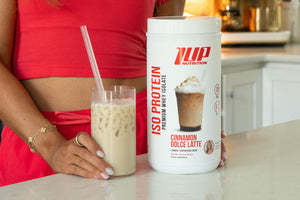Nutrition plays a pivotal role in the success (or failure) of your body transformation challenge.
Most people can gussy up the courage and motivation to hit the gym several times per week, but it’s the food that really trips people up in the long run.
Preparing and cooking your own meals (a.k.a. meal prep) is a commonly recommended strategy to help stick to your diet and make figuring out what foods to eat and when you’ll eat them significantly easier.
While we all are told of the importance of meal prepping, many of you reading this may not know how to efficiently prepare your food each week, thereby saving hours of stress, frustration, and work.
Here, we present 10 kitchen tips to help you meal prep for greater weight loss success.
Whether you’re a meal prep newbie or well-seasoned food prep pro, these tips will help.
Here we go!
Top 10 Kitchen Tips for Weight Loss
Measuring Your Portions
Despite what you may have heard or read elsewhere, calories do matter for weight loss.
Essentially, you must be in a negative energy balance whereby you burn more calories than you consume each day in order to lose weight.
Portion control is often recommended as a way to help keep an eye on how much food you’re eating each day, but it can be hard to use if you’re new to the system.
In an ideal world, you would measure out all of your food, so that you know exactly how many calories you’re eating each day. But, dragging out all manner of measuring cups, portion containers, and food scales can be time-consuming and mentally fatiguing.
That’s why we’ve come up with a “hack” to figure out portion sizes.
All you need for this portion control hack is a regular-sized dinner plate.
Begin by dividing your plate into thirds.
The first “third” of your plate is reserved for a portion of the size of your palm of lean protein.
The remainder of your plate is split between fibrous and starchy carbs.
Since you’re focused on fat loss, you want your plate to contain roughly twice as many fibrous carbs (non-starchy vegetables) compared to starchy carbs (potatoes, rice, quinoa, corn, etc.).
Also, keep in mind that while you are dividing your plate into thirds, you don’t have free reign to stack your plate increasingly higher.
A serving of starchy carbohydrates is roughly the size of your fist. Based on this, your serving of green vegetables (fibrous carbs), should be about double the size.
Meal Prep While Watching TV
A common complaint among individuals who struggle with meal prep is that they “don’t have time.”
Quite frequently, these same individuals do “have time” to watch Netflix for several hours during the week.
Rather than completely veg out during your Netflix binges, use the time to enjoy some TV while meal prepping.
You’ll still be able to watch your favorite shows, and get the benefits of prepping your own food for the week, which will save you considerable amounts of cash and calories since you won’t have to go out to eat.
An easy way to meal prep while watching TV is to utilize commercial breaks. Instead of checking insta-twit-face during commercials, use the time to cut veggies, prep proteins for the oven, or portion out your meals.
If it helps, you can also turn the TV towards your kitchen, or bring your laptop into the kitchen while meal prepping.
Utilize the Spice Rack
One of the biggest complaints of healthy eating is that “diet food is bland.”
Well, if that’s the case, you really have no one to blame but yourself as you should be the one preparing your own food.
If you don’t feel quite comfortable cooking, use some of that TV time we were just discussing to look up easy-to-cook recipes.
There are literally millions of quick-fix, hassle-free recipes on the internet for no charge at all.
Find a couple that appeals to your taste buds and gets to work.
One of our favorite ways to enhance the flavor of food while dieting is to be liberal with the spice rack.
Spices can amp up the flavor “punch” of food without adding calories, the way sauces, dressings, and oil do.
An easy way to experiment with different spice combinations is to try out different seasoning combinations on your batch-cooked proteins.
One of our personal favorite spice blends to flavor chicken, vegetables, or just about anything else is:
- 2-½ tablespoons paprika
- 2 tablespoons onion powder
- 1-½ tablespoons garlic powder
- 1 tablespoon cayenne pepper
- 1 tablespoon white pepper
- 1 tablespoon black pepper
- 1 tablespoon oregano
- 1 tablespoon thyme
Note: Salt has been omitted from the recipe so you can add to your personal liking.
Keep the Healthy Stuff in Plain Sight
When we’re hungry (which is really common when dieting for weight loss), we grab those foods which are readily accessible, regardless if they’re healthy or not.
By knowing this is how most of humanity tends to act, you can put this to good use by keeping micronutrient-rich foods front and center.
Instead of leaving a bag of chips, crackers, or chocolate on the counter, keep a bowl full of fresh fruits there in its place.
The same goes for the refrigerator.
Instead of having the fridge stocked with all manner of ice cream, beer, soda, or other sweet treats, stock it with fresh veggies, string cheese, Greek yogurt, and flavored water.
These simple swaps will translate to tremendous calorie savings over the coming weeks and months of your body transformation challenge.
Don’t Keep Junk Food in the House
The old adage goes: “out of sight, out of mind.”
And, it works really, really well (most of the time).
You’ve probably experienced this for yourself.
If there’s junk food in the house, you’re more prone to eat it, than if you had to drive over to the store to get it.
One easy way to limit your intake of higher calorie fare is to simply not allow yourself to keep it in the house.
This way, if you do get a hankering for sugary, salty, and/or fatty food, you are forced to leave the comfort of your house to get it.
When faced with this option, most people realize that indulgent treat isn’t really needed or worth the hassle.
Measure Out Indulgent (read: junk) Food
Despite the recommendation above, we realize that most people will still keep some sort of snack (junk food) in their cupboards and/or pantry.
Typically, it’s a family-sized bag of chips, tub of ice cream, or bag of chocolates.
Instead of plopping down on the sofa or bed with the entire container and mindlessly munching while watching TV, create your own single-serve portion sizes.
Ideally, you would use a food scale to measure out a single serving portion for yourself, but if you don’t have a food scale (or don’t want to bother with one), buy the “snack-sized” Ziploc bags at the store and use those as a means of portion control.
By limiting your portions, you’ll end up saving hundreds (if not thousands) of calories during your weight loss program.
As an added bonus, by buying the “family size” and portioning out your own individual servings, you’ll save money since the pre-portioned servings at the store typically cost significantly more (due to the added time and materials needed by the food manufacturer to package the smaller serving sizes).
Buy Single-Serve Portions
If you don’t want to be bothered with portioning out your own foods, or don’t have the time to do so regularly, the next best thing is to buy single-serving portions of food.
This is especially useful with calorically-dense foods (starchy carbs, chips, candy, hummus, etc).
Rather than eating your way through an entire container of high-calorie food, buy the single-serving sizes to train yourself what an appropriate serving size is for the food you’re eating.
Be aware that these single-serving options will cost more than if you were to buy the “bulk” or “family serving” size since the manufacturer is going to the added expense of measuring and packaging individual servings for you.
Also, the single-serve lifestyle should be a temporary solution that is to be used only until you start measuring out your own portions.
Limit Eating at Restaurants
Eating is supposed to be a time of relaxation, enjoyment, and socialization.
Yes, food’s primary purpose is to fuel our minds and bodies, but it should also be something that is cherished.
As such, many individuals regularly go out to eat with family, friends, and significant others.
While these times are certainly something to be enjoyed, they can also be akin to navigating a dietary minefield.
The reason for this is that restaurant-dishes are typically “super-sized” (read: “family style”).
This means that although the restaurant says their serving is for 1 or 2 people, it contains enough calories (and food) for 3-4 people.
To make matters worse, even though restaurants list how many calories a particular dish “should” contain, these are estimates at best.
Most restaurant cooks are not taking the time to follow the recipes given to them verbatim or measuring out how much oil they are adding to the pan or sauce they are adding to the final dish when preparing your meal.
This can lead to the consumption of hundreds of extra calories, which can sabotage your weight loss success.
The once-a-week or occasional splurge at a restaurant is ok, but if you’re routinely going out to eat while dieting, you could be unknowingly sabotaging your weight loss efforts.
To help keep portion control in check when eating out, when you order your meal, ask the server to box up ½ of the meal before he brings your dish to the table. You can also split an entree or appetizer with a friend or family member as well as ask for all sauces and dressings to be put on the side.
Invest in an Oil Mister
Fat is essential to human function and well being.
It also helps slow digestion, increases satiety, and makes food taste damn good.
But, it’s also the most calorically-intensive macronutrient, containing ~9 calories per gram.
Many home cooks (and restaurant cooks, too) are rather liberal with cooking oil, choosing to “eyeball” how much fat they use to cook dishes.
For experienced home chefs this may be fine, but for the inexperienced cook, eyeballing your oil pour can result in the consumption of hundreds of extra calories.
Instead of pouring oil or laying a pat of butter into a pan, use an oil mister or can of non-stick cooking spray to cook your eggs, vegetables, and protein.
This helps keep your calorie (and fat) intake in check without sacrificing much in the way of flavor.
Use a Smaller Plate
The final tip on this list to enhance your weight loss is to simply swap your regular-sized dinner plate for a smaller sized version.
Research from Cornell University and the Georgia Institute of Technology[1,2] found that individuals reducing their plate size from 12-inch plates to 10-inch plates resulted in a 22% decrease in calories consumed.
Basically, using smaller plates when eating can encourage you to consume smaller portion sizes, and it may also “trick” your body into thinking that it’s eating more food than you actually are.
One other finding worth mentioning is that using a blue color scheme may help reduce calorie intake as the color blue is believed to act as an appetite suppressant.
Takeaway
Eating healthy to lose weight doesn’t have to be complicated.
If you’re tired of banging your head against the wall trying to decide how to eat for weight loss, try utilizing the tips discussed above.
To lose weight easily, you don’t need to follow any crazy fad diets or eliminate entire food groups from your nutrition plan.
All you need is a little time, patience, and practice in developing an enjoyable, sustainable, and effective fat loss diet.
References
- Wansink, B., & van Ittersum, K. (2013). Portion size me: plate-size induced consumption norms and win-win solutions for reducing food intake and waste. Journal of Experimental Psychology. Applied, 19(4), 320–332. https://doi.org/10.1037/a0035053
- Koert Van Ittersum, Brian Wansink, Plate Size and Color Suggestibility: The Delboeuf Illusion’s Bias on Serving and Eating Behavior, Journal of Consumer Research, Volume 39, Issue 2, 1 August 2012, Pages 215–228, https://doi.org/10.1086/662615






